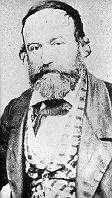Palliser expedition
The British North American Exploring Expedition, commonly called the Palliser expedition, explored and surveyed the open prairies and rugged wilderness of western Canada from 1857 to 1860. The purpose was to explore possible routes for the Canadian Pacific Railway and discover new species of plants. The expedition was led by John Palliser.
Participants
The party consisted of:
- John Palliser, geographer
- James Hector, geologist, naturalist, and surgeon
- Eugène Bourgeau, botanist
- Thomas Blakiston, magnetic observer
- John W. Sullivan, mathematician and sextant observer
-

Captain John Palliser and James Hector
-

Eugène Bourgeau
-

Thomas Wright Blakiston
Expedition routes
Palliser, Hector, Bourgeau, and Sullivan sailed for New York on 16 May 1857.
1857
They sailed from Sault Ste Marie by steamship across Lake Superior. On June 12, they continued in canoes from Isle Royale, Michigan to Lower Fort Garry in Manitoba. The expedition continued with horses and carts, with supplies provided by the Hudson's Bay Company.[1] They continued via the Red River and across the prairies. They met Charles W. Iddings, an American surveyor, along the United States border. The expedition continued through Turtle Mountain, Fort Ellice, Roche Percée, along the South Saskatchewan River to Fort Carlton, then along the North Saskatchewan River, where they spent the winter of 1857/1858.
1858
In the spring they marched west, and searched for mountain crossings west of modern-day Irricana. Palliser and Sullivan mapped the North Kananaskis Pass and North Kootenay Pass before returning to Fort Edmonton for the winter. Hector crossed the Vermilion Pass and discovered the Kicking Horse Pass. During the winter, Palliser, Captain Arthur Brisco and William Roland Mitchell went south to Rocky Mountain House to meet the Blackfoot and Northern Peigan First Nations.
1859
In 1859, the expedition mapped the confluence of the Red Deer River and South Saskatchewan River, as well as the Cypress Hills, before turning again west. Hector crossed the Rockies through the Howse Pass, and tried unsuccessfully to push through to the Pacific Coast. Palliser and Sullivan crossed the mountains through the North Kootenay Pass and continued down the Kootenay River to Fort Colvile, which by then was on American soil as a result of the Oregon Treaty of 1846 and placement of the boundary at the 49th Parallel.
Sullivan explored the Columbia River and its tributaries as far west as the Okanogan Valley, while Palliser crossed over land to Midway, BC. Unable to find passes to the Pacific north of the 49th Parallel, they reunited with Hector in Fort Colville. From there, they traveled 598 miles downstream on the Columbia River to Fort Vancouver and the Pacific Coast, then north to Fort Victoria. The expedition returned to the East Coast by ship through San Francisco and Panama (where they had to go overland to reach a ship to travel in the Atlantic), then to Montreal. From there, they finally sailed back to Liverpool.
Conclusions
After three years of publishing details of the expedition, Palliser presented his report to the British Parliament in 1863. A comprehensive map of the surveyed areas was published in 1865.[2] Palliser's Triangle was first explored by this expedition. They reported to the government that this region was too arid for subsistence agriculture, a finding that was overruled by later officials. That was much to the detriment of those who tried to farm there, particularly when homesteading was encouraged by government grants of land.
The expedition collected and filed astronomical, meteorological, geological and magnetic data, described the fauna and flora of the lands crossed, as well as considerations regarding settlement and transportation.[3] They concluded that transport through American territory was more feasible. While they found several passes suitable for crossing the Rocky Mountains, they were prevented from proceeding to the Pacific by mountains further west.
References
- ↑ Dictionary of Canadian Biography Online. "PALLISER, JOHN". Retrieved 2009-11-15.
- ↑ Spry, I.M. 1968. The Papers of the Palliser Expedition 1857-1860. Introduction and notes by Irene M. Spry. The Champlain Society. Toronto. 694 p. & xix.
- ↑ Our Heritage. "Background on the Palliser Expedition". Retrieved 2009-11-15.
Further reading
- Palliser, John (1863). Exploration - British North America: The journals, detailed reports, and observations relative to the exploration, by Captain Palliser, of that portion of British North America, which, in latitude, lies between the British boundary line and the height of land or watershed of the northern or frozen ocean respectively, and in longitude, between the western shore of Lake Superior and the Pacific Ocean during the years 1857, 1858, 1859, and 1860. London: G.E. Eyre and W. Spottiswoode.
- Palliser, John (1860). Further papers relative to the exploration by the expedition under Captain Palliser of that portion of British North America which lies between the northern branch of the River Saskatchewan and the frontier of the United States; and between the Red River and the Rocky Mountains, and thence to the Pacific Ocean. London: G.E. Eyre and W. Spottiswoode.
- Palliser, John (1859). Papers relative to the exploration by Captain Palliser of that portion of British North America which lies between the northern branch of the River Saskatchewan and the frontier of the United States; and between the Red River and Rocky Mountains. London: G.E. Eyre and W. Spottiswoode.
- Palliser, John (1859). Progress of the British North American exploring expedition under the command of Capt. John Palliser, F.R.G.S. London.